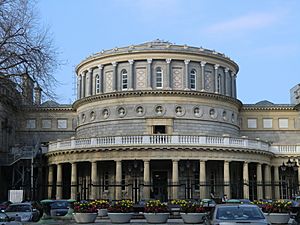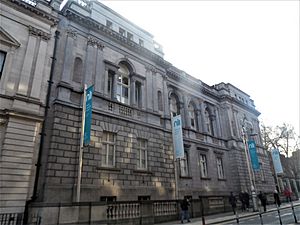National Library of Ireland facts for kids
Quick facts for kids National Library of Ireland |
|
|---|---|
 |
|
| The front façade of the library, 2011 | |
| Country | Ireland |
| Established | 1877 |
| Location | Kildare Street, Dublin |
| Collection | |
| Items collected | Books, journals, newspapers, magazines, manuscripts, maps, prints and drawings, printed music, photographs, ephemera, and websites and databases |
| Size | estimated 8 million items |
| Legal deposit | Yes, since 1927 |
| Access and use | |
| Access requirements | Free. Open to all those who wish to consult the collections for material not otherwise available through the public library service or an academic library. |
| Other information | |
| Director | Audrey Whitty (February 2023–) |
The National Library of Ireland (NLI) is Ireland's main library. It is located in Dublin on Kildare Street. The library's main goal is to collect, keep safe, share, and make available all important documents and information about Ireland. It also helps people find other recorded knowledge.
This library is a reference library. This means you can read books and other materials there, but you cannot borrow them to take home. It has a huge collection of items about Ireland and Irish history. You can use these materials for free. The collection includes books, maps, manuscripts (old handwritten documents), music, newspapers, magazines, and photos.
The library also manages the office of the Chief Herald of Ireland. This office deals with coats of arms and family histories. The National Photographic Archive, which keeps old photos, is also part of the library. The Museum of Literature Ireland is another part, run with University College Dublin. The library often has special exhibitions. It also offers tools and help for genealogy, which is tracing your family history.
The main library building is on Kildare Street. It is right next to Leinster House, where the Irish government meets. It is also near the archaeology part of the National Museum of Ireland.
Contents
History of the National Library
The National Library of Ireland building was finished in 1890. It was built at the same time as the National Museum of Ireland – Archaeology building. Both buildings look very similar and are made of strong stone. The main part is made of granite, and the upper parts use a special sandstone from Donegal.
The library was officially started by a law in 1877. This law said that many collections from the Royal Dublin Society should be given to the public. In 1881, an agreement was made for the library to be run by a group of twelve Trustees. Eight of these Trustees were chosen by the Royal Dublin Society, and four by the government. This system continued for many years.
After Ireland became independent in the 1920s, the library was moved under the Department of Education. In 1927, the library gained "legal deposit" status. This means that publishers in Ireland must send a copy of every book, newspaper, or other item they publish to the National Library. This helps the library collect everything published in Ireland. In 2005, the library became an independent cultural institution. This means it runs itself more freely.
Building Repairs Over Time
Over the years, the sandstone used on the library building started to wear away. This was because of pollution in Dublin's air. In the 1960s, the damaged sandstone was replaced with a strong grey limestone from County Meath. Even in 1993, experts noted that the stone still on the National Museum building showed signs of decay. This decay was caused by the pollution breaking down the stone. Interestingly, the same type of stone in County Donegal, where it came from, did not have these problems.
How the Library is Run
The National Library of Ireland is managed by a board. The daily operations are handled by a director and several heads of different departments. Many important people have been directors of the library over the years.
The current director is Audrey Whitty. She started her role in early 2023.
What the Library Collects
The National Library of Ireland has a huge collection of over 12 million items!
How the Collection Started
The collection began with books and papers from the Royal Dublin Society. It grew a lot after 1927 when it became a "copyright library" for Ireland. This means it receives a copy of most things published in Ireland. A law from 1997 made it clear that the library must collect all materials related to Ireland. This helps create a complete record of Irish publications.
Main Collections
The library's main collection includes items from the Royal Dublin Society and new items received through legal deposit. The library also buys items from Northern Ireland. It tries to collect everything published in the Irish language. The book collection alone has about 1 million books.
Other important collections include:
- Serials: These are publications that come out regularly, like magazines, journals, and annual reports.
- Maps and Drawings: Old and new maps, plus various drawings.
- Government Publications: Official documents from the Irish government and other public groups.
- Manuscripts: Original handwritten documents, which can be very old and unique.
- Newspapers: Both original and microfilmed copies of newspapers.
The library also has a large number of items related to 20th-century Irish poets. It is a key place to find poetry by Irish writers.
Personal Papers of Famous Writers
The National Library of Ireland keeps the personal notes and workbooks of many famous Irish writers. These include:
- Roddy Doyle
- Seamus Heaney
- Michael D. Higgins
- James Joyce
- Edna O'Brien
- Colm Tóibín
- Una Troy
- Sheila Wingfield
- W. B. Yeats
The library also holds the Sheehy Skeffington Papers. This collection includes articles, books, and poems by Irish writers and activists, Francis Sheehy Skeffington and Hanna Sheehy Skeffington. These papers help us understand their influence on Irish culture in the early 1900s. They also give a peek into their family life.
The Cooper Collection is another special part of the library. Austin Cooper (1759–1831) was a clerk from County Tipperary. He made many sketches of old Irish buildings and sites. These sketches were saved by his great-grandson. The Cooper Collection also has drawings by other artists.
Family History Records
The library has an online index of all Catholic parish registers up to the 1880s. These registers recorded baptisms, marriages, and some burials. This is a great resource for anyone researching their family history. The original collection was saved on microfilm and is now available online.
Irish Music Collection
In 2010, the National Library of Ireland started a project to create a free online collection of sheet music. This collection focuses on Irish composers from the 18th and 19th centuries. This project is a team effort with other music organizations.
Digital Collections
In 2019, the library started collecting "born digital" items. These are items that were created digitally and never existed as physical copies. As a test, they received the digital collection of Irish author, Marian Keyes.
See also
 In Spanish: Biblioteca Nacional de Irlanda para niños
In Spanish: Biblioteca Nacional de Irlanda para niños
- List of Ireland-related topics
- National Archives of Ireland
- National Photographic Archive
- Trinity College Library, Dublin


